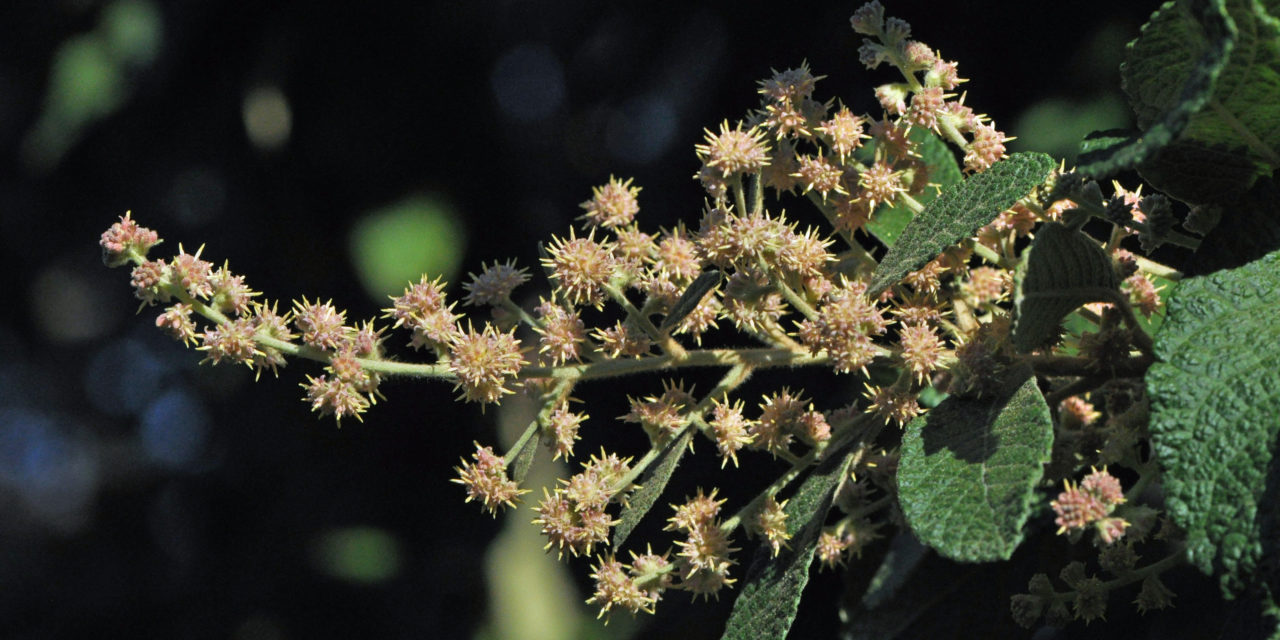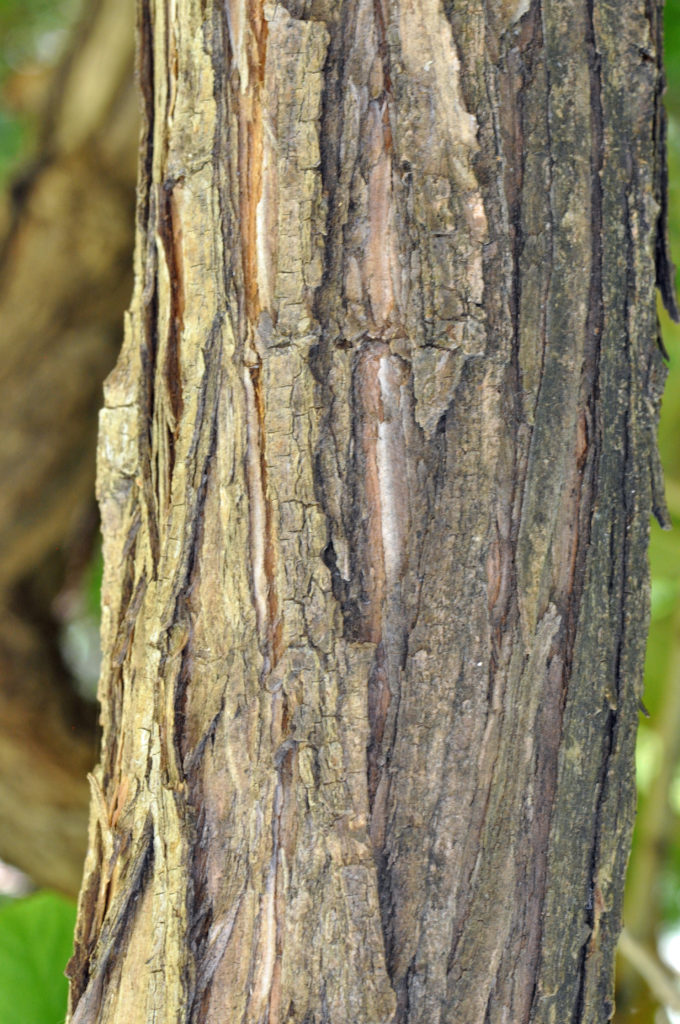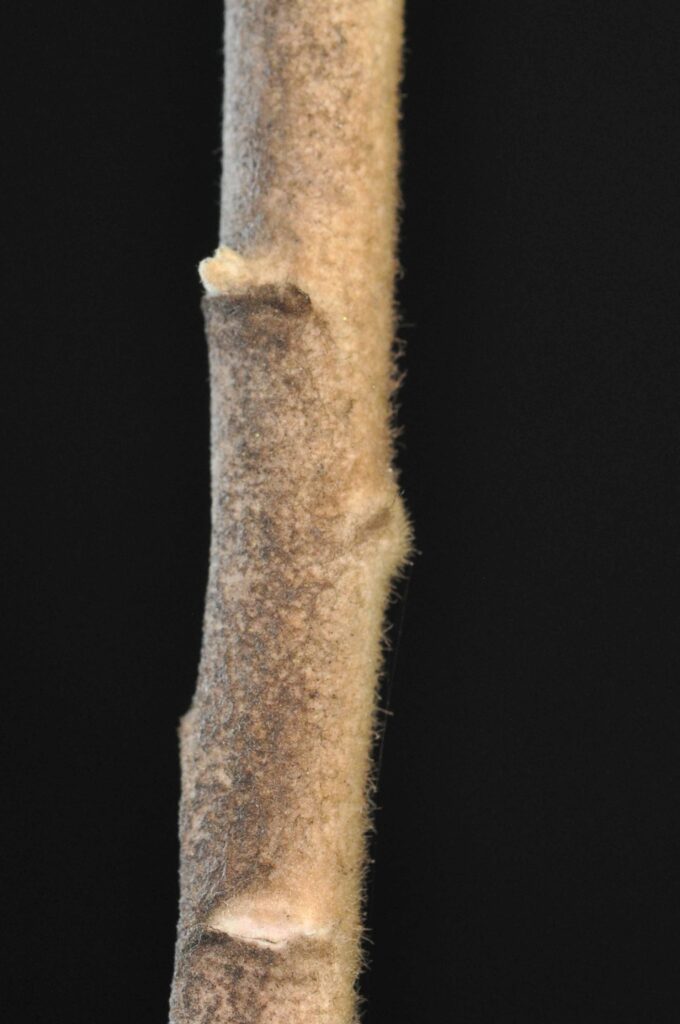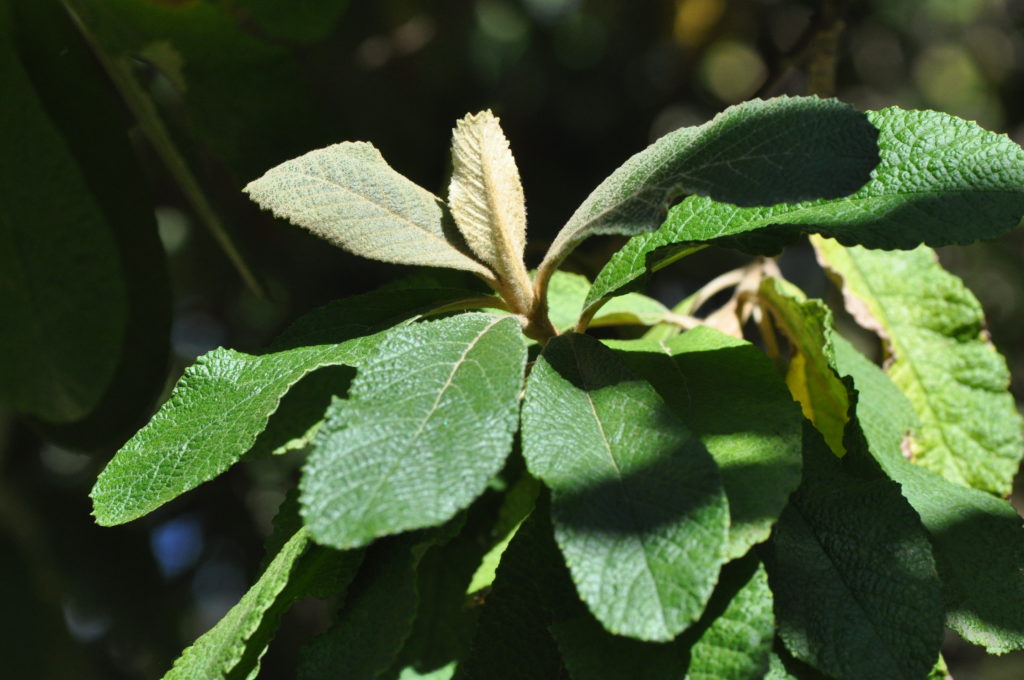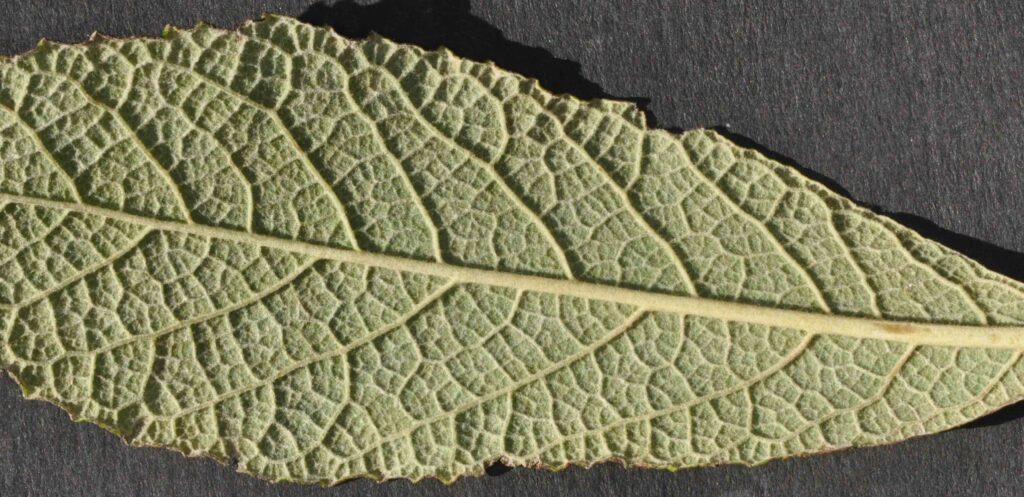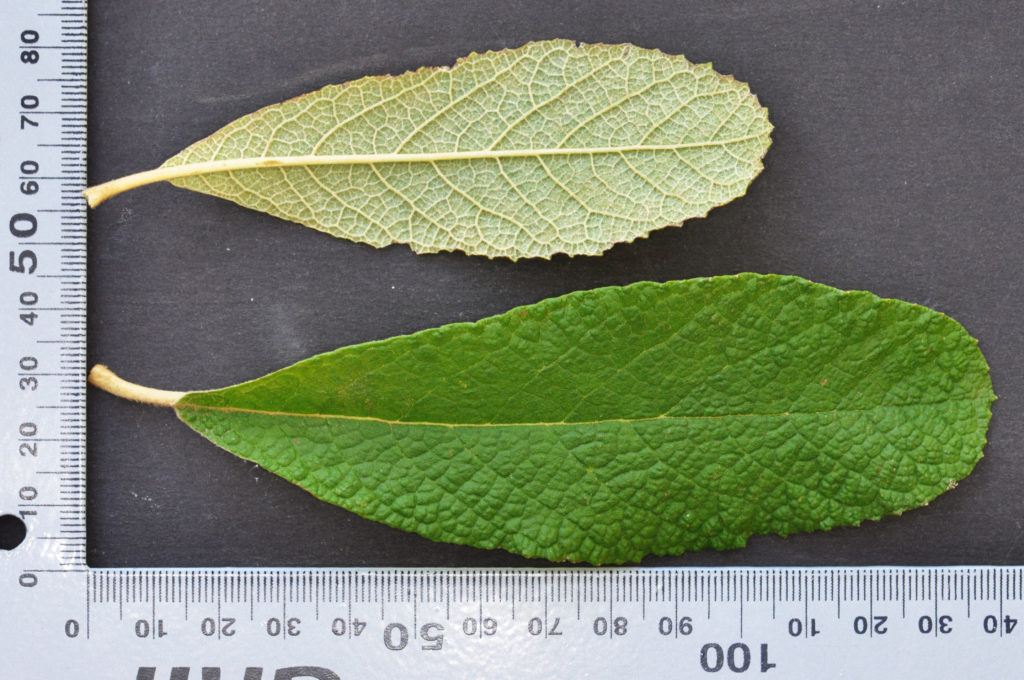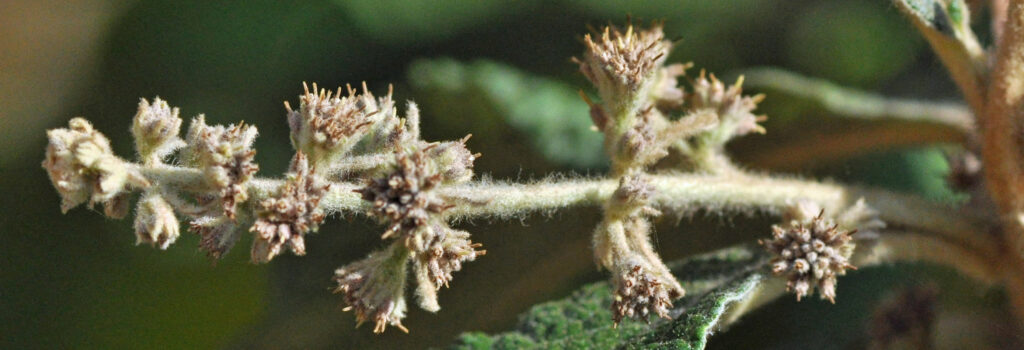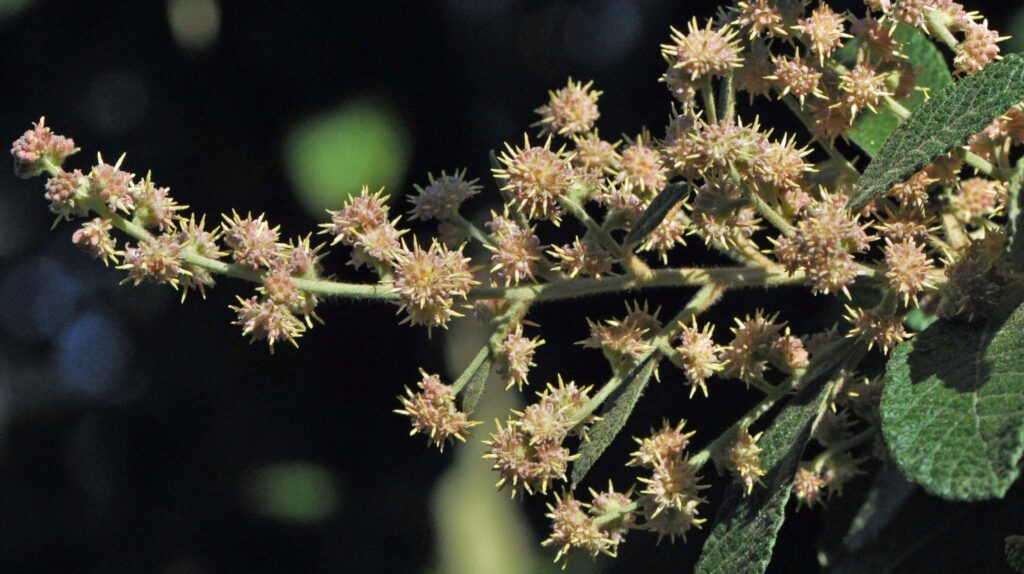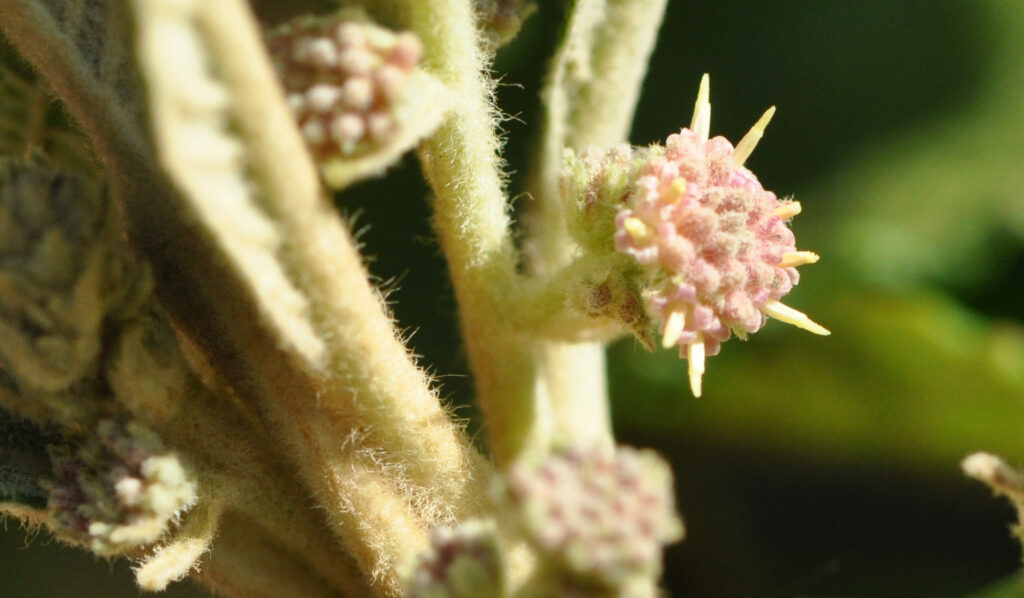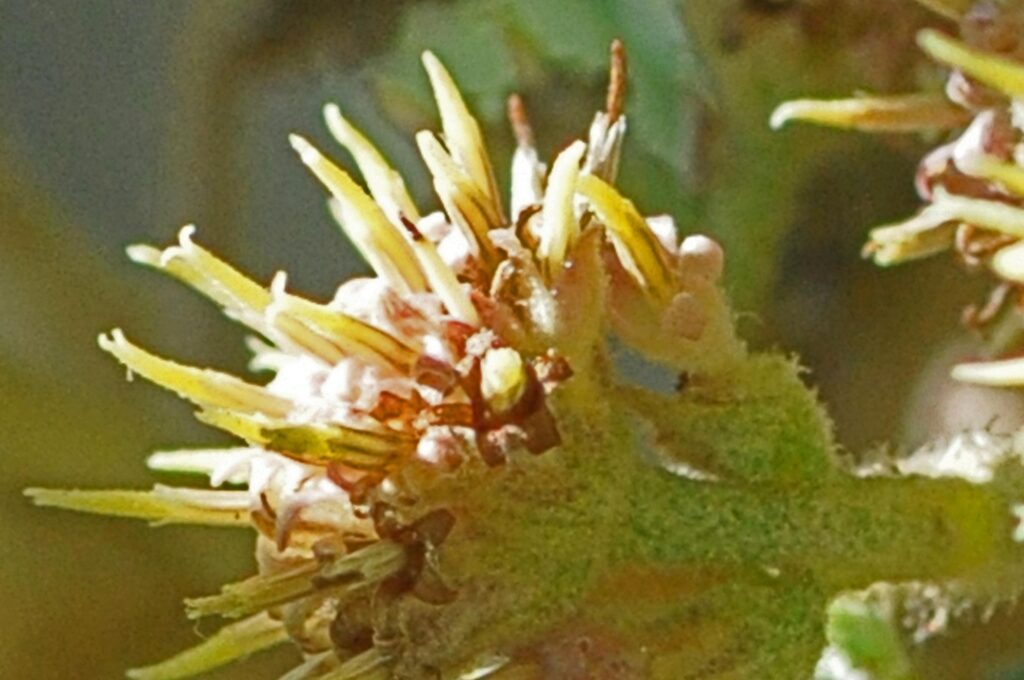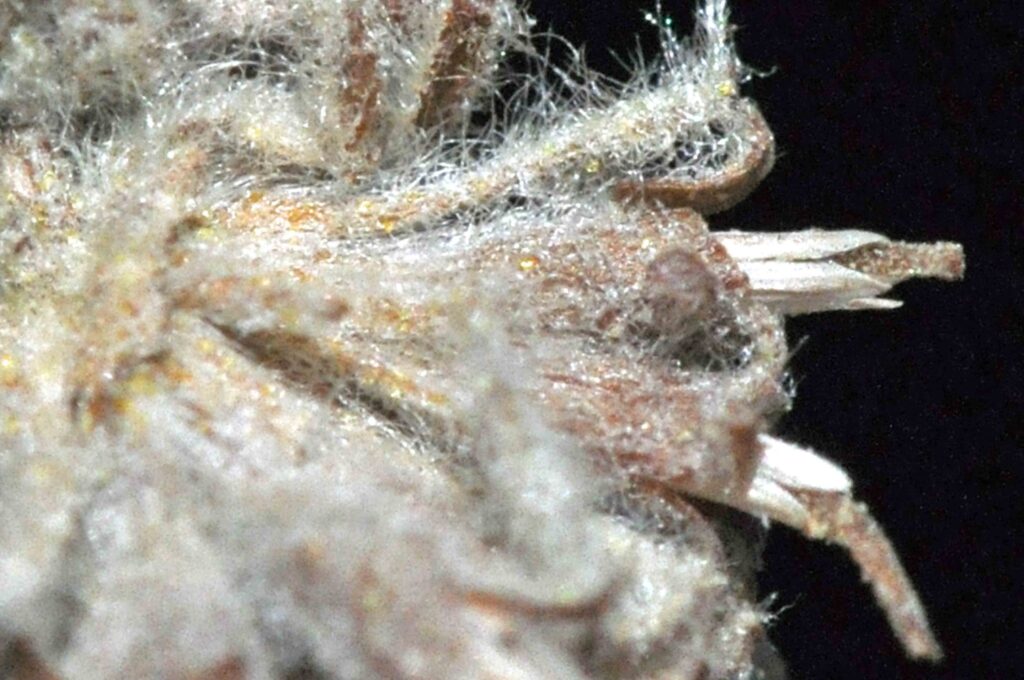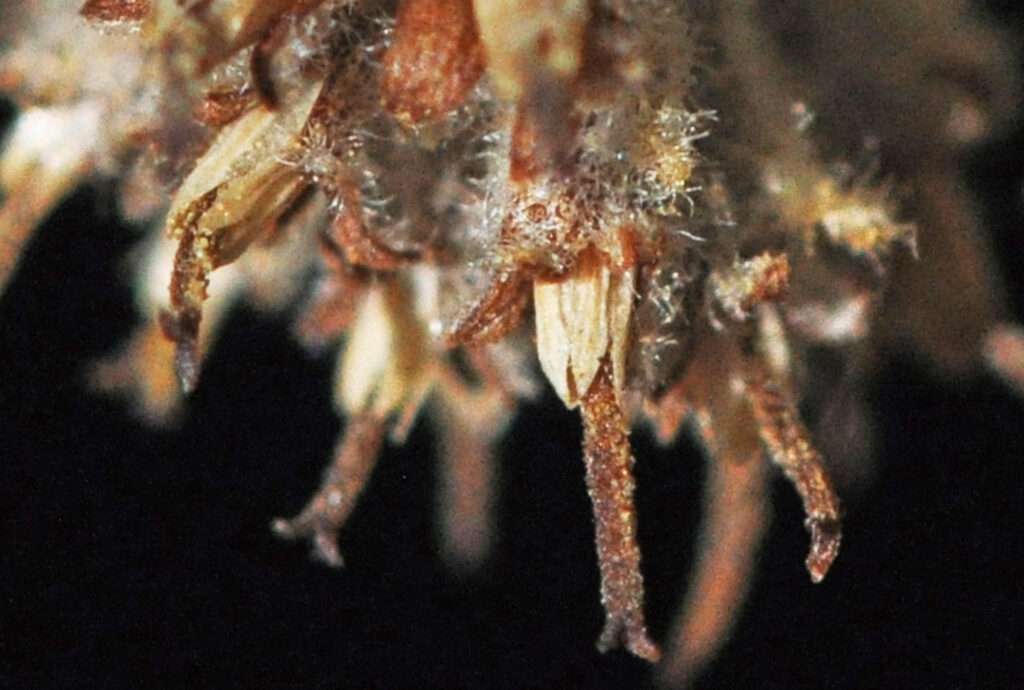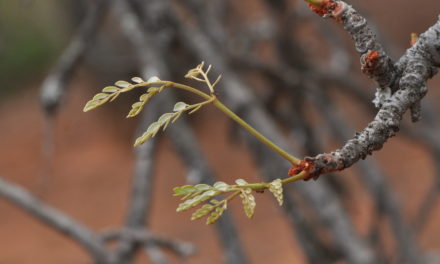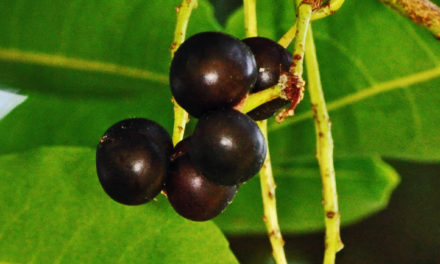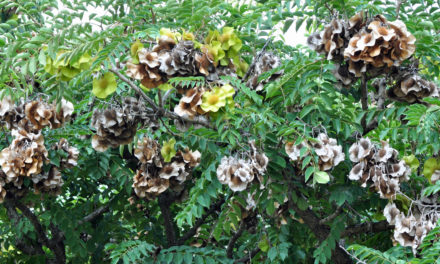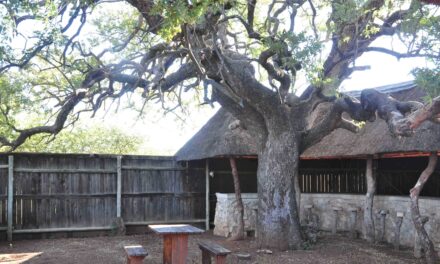General Info – Summary
This evergreen dioecious shrub or Tree is up to 12m high has vertically fissured bark. Hairy twigs have clear leaf scars. The bare trunk is up to 30cm in diameter. Simple Leaves occur near branch ends. The upper surface is corrugated and wrinkled. Small finely hairy Florets are contained within capitula. Male lacks ovary. Female – single pistil & no stamens. Fruit a cypsela up to 5cm wide + 1 wind-dispersed seed.
Description
Tarchonanthus trilobus var. galpinii
Previous Names: Tarchonanthus galpinii.
SA Tree No. 734, 735.
Common names: (Afr) Breeblaarkanferbos. (Eng) Broad-leaved Camphor-bush, Northern Broad-leaved Camphor-bush. (siSwati) ligcebe lematje, Umbebase, ummebasa, Umncweba, qoboqobo, sinukane. (isiXhosa) isiduli-sehlathi. (isiZulu) Isimemela, Igqeba-lamatshe. (Tshivenda) Mutwari.
Family Asteraceae, Compositae. (Daisy family: includes sunflowers, lettuce, chicory, marigolds). There are in excess of 1 900 genera and close to 33 000 species. This is possibly the second biggest plant family. In southern Africa, there are 246 genera and about 2 300 species. Local genera containing trees on this website include Brachylaena, Oldenburgia and Tarchonanthus. Some members have flowers grouped in heads and the whole head may appear to be a single flower – like the “sunflower”. Surrounding each flower are bracts. Individual Flowers in the Asteraceae are called Florets that usually have a base of 5 fused Petals. The Sepals are replaced by a Pappus (is the modified calyx, the part of an individual floret, that surrounds the base of the corolla tube in flower heads of the plant family Asteraceae. The pappus may be bristle, plume, scale or awn like. In all members, the central florets are called Disc Florets. In some members, excluding Brachylaena, the outer florets (Ray Florets) are also present. These occur around the periphery of the flower. Ray florets are usually long and brightly coloured (like the yellow outer florets in the sunflower). Four or 5 stamens are fused to the corolla. An inferior Ovary is present containing 1 Ovule and the Style has 2 lobes. Each floret produces 1 Fruit with 1 Seed.
Name derivation: Tarchonanthus – funeral flower – perhaps because the crushed leaves smell of camphor. trilobus – 3 lobes – referring to the apex of some leaves in variety trilobus. There are 6 tree species of Tarchonanthus currently recognised in southern Africa.
Conservation: National Status: L C. (Least concern). Assessment: 2005 (W. Foden & L. Potter).
Tree
This plant may be a shrub or Tree (photo 228) up to 12m high (usually less). The stout single bare Trunk may reach 30cm in diameter. The grey to dark grey and roughly vertically fissured Bark (photo 226) is visibly cracked and flakes in narrow pieces. Twigs (1-year-old current branch segments) are light, hairy or woolly and have clear leaf scars (photo 541).
- 228. 2014/10/21. Walter Sisulu NBG. Photo: David Becking.
- 226. 2014/10/21. Walter Sisulu NBG. Photo: David Becking.
- 541. 2017/07/18. Walter Sisulu NBG. Photo: David Becking.
Leaves
This evergreen tree has thick dark green to olive green non-shiny Leaves (photo 141) that are simple (have a single blade that may have incisions that are not deep enough to divide the blade into leaflets). They are slightly aromatic (smelling of camphor). Leaves occur towards the ends of branches. They are spirally arranged and oblong-elliptic or obovate (the reverse of ovate, the terminal half is broader than the basal) or narrowly so, or widely lanceolate and up to 20 x 7+cm (photo 142). The Upper surface dark green to olive green and has deeply immersed veins causing the leaf to appear roughly corrugated and wrinkled (photo 142). The mature leaf is hairless above. The raised veins on the Lower surface are prominent (photo 144). Here the persistent, creamy white densely woolly hairs do not hide the veins (photo 142). The Midrib (a continuation of but excludes the petiole) is sunken above and protrudes below. The Apex may be 3-lobed in variety trilobus). The apex may be broad and rounded to broadly tapering and may have 5-8 teeth. The Base tapers. The Margin is almost entire (with a continuous margin, not in any way indented but may be hairy) or crisped crinkly and irregularly toothed – especially near the apex (photo 142). The stout Petiole (leaf stalk) is woolly and up to 3cm long. The petiole and young leaves are initially covered with dense, creamy woolly hairs (photo 141) which may wear away with time. The photos on this website are of Tarchonanthus trilobus var. galpinii. In T. var. trilobus the leaf apex may terminate in 3-5 lobes.
- 141. 2014/08/26. Walter Sisulu NBG. Photo: David Becking.
- 144. 2014/08/26. Walter Sisulu NBG. Photo: David Becking.
- 142. 2014/08/26. Walter Sisulu NBG. Photo: David Becking.
Flowers
The axillary (in the axil – growing between stem and leaf), pale yellowish to cream and numerous flowers are called Florets (individual flowers mainly in the Asteraceae and grasses that make up a dense form of inflorescence) are straw-coloured and very small – here a hand lens will help. The florets are finely hairy throughout. The plants are dioecious (unisexual floral structures with male and female parts on separate plants). The inflorescence is a Capitulum (a dense inflorescence composed of an aggregation of flowers on a flattened axis). Capitula are contained within a Panicle (indeterminate, branched inflorescence with stalked flowers – photo 122). They lack Ray florets (outer modified florets as in the sunflower). The Corolla is tubular to funnel shaped with 5 recurved lobes (photo 707). MALE Florets occur in heads of 10-16. Here there is no ovary although a long thin style is present. The Stamens produce pollen in the terminal Anthers that are calcarate (spurred) and caudate (having a tail-like appendage). FEMALE Florets contain single flowers and have a 4-6 lobed Corolla with external woolly hairs. The corolla is shorter than the ovary. There is a single Pistil (a unit of the Gynoecium, the female element of the flower, composed of the Ovary, Style and Stigma) with an inferior ovary (here the ovary is enclosed in the Receptacle (the expanded tip of the flower stalk from which the floral parts develop. It is greatly expanded in the Asteraceae and Ficus). The other floral parts situated above. The Ovary is unilocular (containing a single chamber or cell). There is a single, simple exserted Style (more or less elongated part of the pistil situated between the ovary and the stigma). Female flowers lack Stamens. (Jan-Sep).
- 707. 2017/08/08. Walter Sisulu NBG. Photo: David Becking.
- 122. 2016/05/31. Walter Sisulu NBG. Photo: David Becking.
- 397. 2015/05/19. Walter Sisulu NBG. Photo: David Becking.
- 304. 2015/09/15. Walter Sisulu NBG. Photo: David Becking.
- 469. 2018/07/25. Walter Sisulu NBG. Photo: David Becking.
- 468. 2018/07/25. Walter Sisulu NBG. Photo: David Becking.
Fruit
Fruit is woolly and located in terminal clusters – in heads. Each wind disperse fruit is a Cypsela (Asteraceae fruit – a dry, single-seeded fruit formed from a double ovary of which only one develops into a seed). It is about 5mm in diameter including the covering of fine silky hair. (Jan-Oct). A Pappus (modified outer perianth series of Asteraceae, borne on the ovary and it may be bristle, plume, scale or awn like) is absent but is present in the genus Brachylaena.
Distribution & Ecology
This plant occurs naturally in the Northern Cape, KwaZulu-Natal e.g. near the Oribi Gorge hotel, Gauteng, North West, Limpopo. Beyond South Africa, it occurs in Swaziland, Namibia and the Lebombo mountains in Mozambique and Zimbabwe. It is thus a southern Africa Endemic (restricted to a particular geographic location). The tree grows on rocky outcrops, in bushveld, evergreen forest margins, woodland, wooded grassland and margins of evergreen forests. It is less common in dry forests. Black rhino graze the leaves, stems and flowers. Game including rhino browse the leaves and stems. Both the stem and leaves have a smell of camphor.
In Tarchonanthus trilobus var. trilobus the leaf apex is distinctly 3-lobed and this plant is more common further south in KwaZulu-Natal and the Eastern Cape.
Ethnobotany
The bright, aromatic (camphor), brown Wood with its yellow graining is hard and durable. The plant is best grown from seeds that should be planted in early spring. The tree is quick growing and has non-invasive roots. Oils extracted from the leaves have some antibiotic properties.
References
Boon, R. 2010. Pooley’s Trees of eastern South Africa. Flora and Fauna Publications Trust, Durban.
Burrows, J.E., Burrows, S.M., Lotter, M.C. & Schmidt, E. 2018. Trees and Shrubs Mozambique. Publishing Print Matters (Pty) Ltd. Noordhoek, Cape Town.
Coates Palgrave, M. 2002. Keith Coates Palgrave Trees of Southern Africa, edn 3. Struik, Cape Town.
Foden, W. & Potter, L. 2005. Tarchonanthus trilobus DC. var. galpinii (Hutch. & E.Phillips) Paiva. National Assessment: Red List of South African Plants version 2020.1. Accessed on 2024/02/14.
Palmer, E. & Pitman, N. 1972. Trees of southern Africa. Balkema, Amsterdam, Cape Town.
Schmidt, S. Lotter, M. & McCleland, W. 2002. Trees and Shrubs of Mpumalanga and the Kruger National Park. Jacana, Johannesburg.
van Wyk, B. & van Wyk, P. 1997 Field guide to Trees of Southern Africa. Struik, Cape Town.
http://www.plantzafrica.com/planttuv/voteplant.php
http://www.greenplanet.co.za/plant/Tarchonanthus-trilobus
http://posa.sanbi.org/flora/browse.php?src=SP
https://www.zimbabweflora.co.zw/speciesdata/genus.php?genus_id=1483

